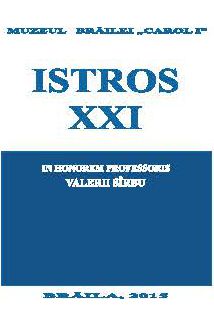Opinii privind necropola din jurul rotondei de la Ilidia. Întregiri la arheologia funerară medievală
Opinions concerning the necropolis around the rotunda from Ilidia. Completions regarding the funeral medieval archaeology
Author(s): Dumitru ŢeicuSubject(s): History
Published by: EDITURA ISTROS A MUZEULUI BRĂILEI „CAROL I”
Keywords: cemetery; church rotunda; center of power; Banat, XIIIth-XVth centuries.
Summary/Abstract: The approach we proposed lately, especially regarding the monuments of medieval architecture from Ilidia, have tried to bring into attention and to return the history of a medieval center of power which has remained, until now, into an undeserved obscurity.Together with the rotunda, in 1969 there were identified a number of funerals around it. The church rotunda has been investigated in 1969 and 1972 and preserved in situ in 1974. The cemetery around the rotunda was investigated concurrently with the monument, and also during the following years, between 1978-1980.The 70 graves identified occupies a small area in the immediate vicinity of the space around the rotunda. The cemetery is thus integrated into an active space, which carried the life of a feudal court, because the rotunda of Ilidia has constituted a part of the feudal noble court built nearby, onto the Obliţa hill. The graves were arranged in regular rows around the church rotunda.The court church from Ilidia-Obliţa is part of a series of eight medieval churches in Banat, known to the present date, around which cemeteries have been organized. Along with court churches from Ilidia and Reșița, and the parish ones in Mehadia, Berzovia, Cârnecea, Obreja and Opatiţa, cemeteries have also been organized around churches and monasteries in Cusici, Baziaş or Caransebeş. The above-mentioned ecclesiastical monuments mostly belong to the Orthodox confession, but also to the Catholic one, through such churches as the ones in Opatița, Berzovia, and the Franciscan monastery in Caransebeş.In Romanian historiography, the practice of burying the defunct with his arms and palms brought up to the wishbone has been loaded with ethnic and religious connotations. Tombs with this variant of funerary ritual discovered in Banat and Bărăgan have been considered to be bogomile funerals and, as such, they were assigned to a group of Slavs who supposedly have came over from Bulgaria and Serbia during the 12th-15th centuries.The identitary construction regarding the "bogomile graves" is, in my opinion, an extremely shaky one, and without solid documentary sustainability. It explicitly states the existence of mixed ethnic and confessional communities, in medieval Banat. Medieval documents not only contradict such a supposition, but they also firmly illustrate a permanent conflict, during the 14th-15th centuries, between the communities of "hospites" established in the Banat plains and the surrounding Romanian villages.
Journal: ISTROS
- Issue Year: 21/2015
- Issue No: 1
- Page Range: 579-619
- Page Count: 41
- Language: English, Romanian
- Content File-PDF

